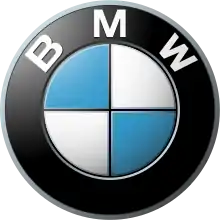BMW Motorrad
BMW Motorrad is the motorcycle brand of the German company BMW, part of its Corporate and Brand Development division.[1] It has produced motorcycles since 1923, and achieved record sales for the fifth year in succession in 2015. With a total of 136,963 vehicles sold in 2015, BMW registered a growth of 10.9% in sales in comparison with 2014.[2] In May 2011, the 2,000,000th motorcycle produced by BMW Motorrad was an R1200GS.[3]
 | |
| Product type | Motorcycle brand |
|---|---|
| Owner | BMW |
| Markets | Worldwide |
| Website | www |
History
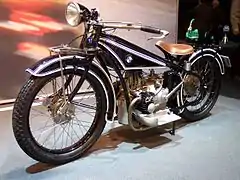
The company began as an aircraft engine manufacturer in the early 20th century and through World War I. BMW manufactured its first motorcycle in 1923, the R32, which featured a flat-twin boxer engine. BMW Motorrad still uses the flat-twin boxer configuration, but now manufactures motorcycles with a variety of engine configurations.
Current production


.jpg.webp)
With the exception of the G310 series (which is produced at TVS's Tamil Nadu, India plant[4][5]), all BMW Motorrad's motorcycle production takes place at its plant in Berlin, Germany.[6] Some engines are manufactured in Austria, China, and Taiwan. Most of the current motorcycles in BMW Motorrad's range were designed by David Robb, who was the company's chief designer from 1993 to 2012 when he was replaced by Edgar Heinrich.[7][8][9]
The most popular model is the R1200GS and its sibling R1200GS Adventure, which sold 24,467 units – accounting for 28% of BMW's annual production.[10] Current production includes a variety of shaft, chain, and belt driven models, with engines from 310 cc to 1,802 cc; and models designed for off-road, dual-purpose, sport, and touring activities.
In 2008, BMW introduced the DOHC Boxer HP2 Sport,[11] and entered the serious off-road competition motorcycle market with the release of the BMW G450X motorcycle.[12]
BMW Motorrad motorcycles are categorized into product families, and each family is assigned a different letter prefix. The current families are:
- C series – Maxi-scooters called Urban Mobility Vehicles by BMW
- F series – parallel-twin engines of 798 cc capacity, featuring either chain or belt drive. Models are F650GS, F700GS, F800GS, F800R, F800S, F800GT and F800ST. The F650GS was powered by a single cylinder 652cc Austrian built Rotax engine.
- G series – single-cylinder engines of 449 to 652 cc capacity featuring chain drive. Models are G450X (now discontinued), G650GS, G650 Sertão, G650 Xmoto, G650 Xchallenge and G650 Xcountry. The 450 cc engines are manufactured by Kymco in Taiwan.[13] The 2009 and 2010 650 cc engine parts were manufactured by Rotax in Austria, with the engine being assembled by Loncin Holdings, Ltd in China.[14][15] Arriving in 2016, is the BMW G310R, a single-cylinder liquid-cooled model manufactured in India by TVS Motor Company.
- R series – twin-cylinder boxer engines of 1,170 cc capacity featuring shaft drive. Models are R1250GS, R1200GS, R1200R, R1200RT, R1200RS, R1200S, R nineT and R18.
- K series – four-cylinder engines of 1,157 to 1,649 cc capacity featuring shaft drive. Models are K1200LT, K1300GT, K1300R and K1300S. In 2011, BMW Motorrad launched the six-cylinder 1,649 cc K1600GT and K1600GTL.[16]
- S series – S1000RR – sport bike with transverse-mounted, 999 cc inline-four engine. Models included S1000R, S1000XR
Sales
BMW Motorrad achieved record sales for the fifth time in succession in 2015. With a total of 136,963 vehicles sold in 2015, BMW registered a 10.9% increase in sales in comparison with 2014. The biggest single market in 2015 was once again Germany (23,823 units), followed by the United States (16,501 units), France (12,550 units), Italy (11,150 units), United Kingdom (8,200 units) and Spain (7,976 units).
With an aim for 2020 to supply 200,000 vehicles to customers, BMW Motorrad is targeting an increase of its dealership from around 1,100 to 1,500 in the future. As it was the case until now, BMW's most successful motorcycle is still the R 1200 GS with 23,681 units sold in 2015.[2]
Ferrari Lamborghini Bmw
| 2010 name | Team Alpha BMW |
|---|---|
| Base | Rosenheim, Germany |
| Team principal/s | Berti Hauser |
| Race riders | 91 Leon Haslam 11 Troy Corser |
| Motorcycle | BMW S1000RR |
| Tyres | Pirelli |
| Riders' Championships | 0 |
BMW Motorrad regularly enters its motorcycles in the Dakar Rally, an annual car, truck, and motorcycle race held traditionally on European and African land and recently, in South America,[17] has featured riders such as Simon Pavey and motorcycling celebrity Charley Boorman. BMW Motorrad motorcycles have won the Dakar Rally six times.[18][19]
In 2007, BMW Motorrad announced their entry to the 2009 Superbike World Championship season, running their S1000RR bike. The 2009 season factory team was known as Team Alpha BMW and includes Spanish rider Ruben Xaus and Australian rider Troy Corser.[20] In the 2010 season, Xaus and Corser were joined on the track by Team Reitwagen BMW riders Andrew Pitt and Roland Resch, also riding the S1000RR.
Isle of Man TT
In recent years BMW Motorrad have enjoyed renewed success at the Isle of Man TT Races. Prior to 2014, the last success in the solo categories at the event was in 1939, when Georg Meier won the Senior TT. After 75 years BMW again took top spot on the rostrum at the 2014 Isle of Man TT when Michael Dunlop piloted a BMW S1000RR to first place in the opening Superbike race. Michael Dunlop then rounded off the week with victory in the Senior TT.[21]
At the 2016 Isle of Man TT, Michael Dunlop again took the honours in the opening Superbike TT for BMW. Dunlop led the race from start to finish from another BMW rider, Ian Hutchinson. Dunlop also established a new outright lap record, at 133.962 mph (215.591 km/h)[22] and set a new race record of 1 h 44 min 14.259 s, after 226 miles (364 km) of racing.[23]
BMW sidecars also had numerous successes at the TT Races, primarily during the 1960s and early 1970s.
In total, BMW have won 34 Isle of Man TT races, in both the solo and sidecar divisions.[24]
Engine types
There are four lines of BMW motorcycles:
- F & G series singles
- F series twins
- R series
- K series
The series differ primarily in the class of engine that each uses.
F and G series singles
The F Series of single-cylinder BMW motorcycles was first launched in 1994, as the F650, and was built by Aprilia around a carbureted 650 cc four-stroke, four-valve, single piston engine, and chain drive. The mission for the F 650 was to provide an entry level BMW motorcycle. In 2000, the F650 was redesigned, now with fuel injection, and labeled the F650GS. An off-road focused F650 Dakar model was also launched that year. 2002 saw the addition of the F650CS 'Scarver' motorcycle to the line up. The Scarver was different from the F650GS variants in that it utilized a belt drive system opposed to a chain, had a much lower seat height, and was intended for on-road use. All F650 motorcycles produced from 2000 to 2007 used a 652 cc engine built in Austria by Rotax and were built by BMW in Berlin.
In late 2006, the G series of offroad biased bikes motorcycles was launched using the same 652 cc engine fitted to the F650GS, although that engine is no longer manufactured by Rotax. The latest version of the 652cc single engine fitted in the new G650GS is now produced in Berlin after 2 years production in Loncin, China.
In November 2007, the G450X sport enduro motorcycle was launched using a 450 cc single-cylinder engine. The G450X contained several technological improvements over the Japanese off-road racing motorcycles but the most unusual and significant was the use of a single pivot point for the drive sprocket and the swing arm. This unusual configuration allowed for a very tense drive chain with no slop and eliminated acceleration squat. The former benefit saves on chain and sprocket wear and the latter allows for a more consistent drive geometry and fully available rear suspension travel during heavy acceleration.
F series twins
In mid-2006, The F Series added two new motorcycles to the lineup, the F800S sports bike and F800ST sports tourer, both which use a 798 cc parallel-twin engine built by Rotax. Both motorcycles also feature a belt drive system similar to what was in use on the F650CS. In 2007 the single-cylinder F650GS was replaced with the twin-cylinder F800GS and F650GS models. The latter uses a de-tuned version of the 798 cc engine fitted to the F800GS,[25] marking a departure from BMW's naming convention.
R series flat-twins

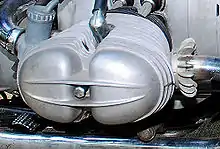
The R series are built around a horizontally opposed flat-twin (boxer) engine. As the engine is mounted with a longitudinal crankshaft, the cylinder heads protrude well beyond the sides of the frame. Originally, R series bikes had air-cooled heads but are now produced only with partial oil cooling or water cooling. The type of internal combustion engine cooling used across the various R series engines leads to the use of the distinguishing names airhead and oilhead.
Airheads
Airheads are BMW motorcycles with an air-cooled vertical-single or horozintally-opposed twin engine that were built from 1923 to 1995. Most airheads made from 1969 to 1995 used the BMW 247 engine, although 248/1 engines were used on mid-sized R-series motorcycles from 1978 to 1993. Even high-performance motorcycles, such as the R90S used the 247 engine;[26] and its successor, the R100RS, was fitted with an oil cooler.
Oilheads
An "Oilhead" is a name to describe BMW flat-twin motorcycle engines with partial oil-cooling, and to distinguish these engines from the earlier air-cooled "Airhead" models.[27] The Oilhead's finned cylinders have conventional air-cooling, but the four-valve cylinder-heads are oil-cooled. Unlike earlier BMW boxers which had a single camshaft in the crankcase (variously above or below the crankshaft), the Oilhead has a camshaft in each head. (It is still technically an overhead valve engine rather than a true overhead camshaft unit, as the camshaft bears onto very short pushrods which operate valve rockers). In 2013, BMW introduced water-cooling to its boxer range.[28] The engine is still used in the BMW R nineT[29] line of motorcycles.
In April 2020 BMW launched its cruiser BMW R18 with BMW's largest boxer engine featuring 1,802 cc (110.0 cu in), 90 hp (67 kW) and 158 N⋅m (117 lbf⋅ft).[30]
Water-cooled boxer engines
From 2013 (R1200GS), some BMW bikes have water-cooled-heads, but (like the oilheads), the new engines still use air-cooling for the cylinders. Approximately 34% of the cooling is attributed to the water-cooling which is concentrated in the highest heat generating areas such as around the exhaust-valve seats, etc.
The inlets are now on top of the cylinder (not behind as before) and the exhausts are below (no longer in front).
R series singles
Between the introduction of the R39 in 1925 and the discontinuation of the R27 in 1967, BMW made motorcycles with single-cylinder engines. These were similar in design to their larger flat-twin motorcycles, including the use of shaft drive, but the engine was mounted vertically within the frame.[31]
K series straight engines
The K series BMWs have water-cooled engines of three (K75), or four (K100, K1100, K1200, K1300), or six (K1600) cylinders. Up until 2004, all K series engines, whether three or four cylinders were that of the original "flying brick" layout, so called due to the external appearance of the engine. The layout of these original K engines is unique within motorcycling in that the engine is mounted lying on its side, with the crank on the right side of the bike and the cylinder heads and valve gear on the left. This format had the advantage of allowing the drive system to have only one 90-degree translation within the final drive housing, potentially reducing drive train losses. All of the original format K engines were also mated to a dry automotive-type clutch. The uniform use of the traditional K engine ceased with the K1200 models in 2005, with a new 1200 series engine that was radically different from the flying brick in that it was a conventional transversely 55-degree slant-mounted four-cylinder engine coupled to a wet clutch and a unitary construction gearbox. It was at this time also that the K bike shaft drive moved from the right side to the left. Despite this new engine, the traditional flying brick K engine continued in service with the giant K1200LT luxury touring bike until 2009, at which point the flying brick bowed out along with the K1200LT. This was the event that presaged the development of the ultimate K engine in terms of size and complexity, the six-cylinder K1600 series fitted to the K1600GT and GTL models.
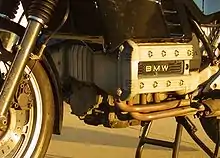
The first K-series production bike was the K100, which was introduced in the 1983. In 1988, BMW introduced the K1 which had the Bosch Motronic fuel injection system.
From 1985 to 1996, the K75 740 cc three-cylinder engine was produced.
In 1991, BMW increased the displacement of the K100 from 987 cc to 1,097 cc and the model designation became the K1100. The K1100LT was the first with the new engine displacement. In 1998 BMW increased the size again to 1,170 cc. This upgraded flat four engine appeared in the K1200RS. This engine continued in production for the K1200LT range, with a power boosting update in 2004, until the end of the LT production run.
The later K1200 engine is a 1,157 cc transverse inline-four, announced in 2003 and first seen in the 2005 K1200S. The new engine generates 123 kW (165 hp) and is tilted forwards 55 degrees. It is 43 cm (17 in) wide, giving the bikes a very low center of mass without reducing maximum lean angles.[32]
In October 2008, BMW announced the new K1300GT, K1300S and K1300R models, all of which feature a larger capacity 1293 cc engine producing up to 175 hp (130 kW). The new engine produces maximum power output 1,000 RPM lower than the previous engine, producing more torque due in part from a butterfly flap fitted in the exhaust.
In 2011, BMW launched the K1600 range—the K1600GT and K1600GTL—featuring a new 1,649 cc (100.6 cu in) straight-six engine, which is mounted transversely across the chassis.[33] The engine is angled forward by 50°.[34] The engine was originally used on the Concept 6, a concept bike that was shown at the 2009 EICMA Milan Motor Show.[35] BMW claims that the engine at 560 mm (22 in) wide, just 67 mm (2.6 in) wider than the K1300 engine,[34] is the narrowest six-cylinder engine ever produced. Cylinder bore is 72.0 mm (2.83 in) and the distance between cylinder centres 77 mm (3.0 in).[34] The camshaft is hollow, with cam lobes pressed on, which saves around 2 lb (0.91 kg).[36] The engine has electronic throttle control and multiple drive modes which can be set according to road conditions.
Model designation
BMW uses a three-segment nomenclature for motorcycles. The first segment indicates the engine type, the second indicates the approximate engine displacement in cubic centimeters (with one notable exception: the F 650 GS, which has an engine displacement of 798cc[37]), while the third indicates the class of motorcycle (e.g., sport, sport touring, dual-sport, etc.). The three segments are separated by blanks.[38][39][40]
A similar 3-segment nomenclature is used for BMW automobiles. However, there is significantly less consistency across the range with respect to the second segment (engine displacement/100).
Engine type:
- R – air-cooled, horizontally opposed ("boxer") 2-cylinder, oil-cooled 1994–2013, water-cooled starting with the 2013 R1200GS and 2014 R1200RT
- K – water-cooled, inline 3-, 4- or 6-cylinder
- F – water-cooled, vertical 1-cylinder (through 2006), vertical 2-cylinder (after 2006)
- G – water-cooled, vertical 1-cylinder
- S – water-cooled, inline 4-cylinder superbike
Engine displacement in cc:
- Current models: 1600, 1300, 1250, 1000, 900, 800, 650, 400 and 310. Previous models included 450, 850, 1100, 1150 and 1200.
- Older model BMWs divide the approximate engine displacement by ten for the model number. For example, K75 ≈ 750 cc.

Styling suffix designations:
- B – Bagger
- C – Cruiser
- CS – Classic Sport
- G/S – Gelände/Strasse Off-road/Street
- GS – Gelände Sport Off-road Sport (Enduro)
- GT – Gran Turismo or Grand Touring
- LS – Luxury Sport
- LT – Luxus Tourer (Luxury Tourer)
- R – Road or Roadster, typically naked
- RR – Racing Replica
- RS – Originally stood for Rennsport, but since 1976 has stood for Reisesport[41]
- RT – Reise Tourer (Travel Tourer)
- S – Sport
- ST – Strasse (Street) or Sport Tourer
- T – Touring
Additionally, a bike may have the following modifiers in its name:
- A – ABS
- L – luxury
- P – police
- C – custom
- PD – Paris Dakar
Examples: K 1200 S, R 1200 RT, F 650 GS, R 1150 RSL, K 1200 LT, K 1200 LT-C, R 1200 RT-P, R 1200 RSA, S 1000 RR.
Prior to the introduction of the K 100 series and the R 1100 series motorcycles, the letter prefix was always the same, and the numbers were either based on displacement, as mentioned above, or were just model numbers.
Technologies
Single-sided rear suspension
The first BMW monolever suspensions appeared in 1980 on the then-new R80G/S range. It had a single universal joint immediately behind the engine/gear-box unit. This system was later included on updated versions of the K & R Series.
Paralever
Paralever is a further advance in BMW's single-sided rear suspension technology (photo right). It decouples torque reaction as the suspension compresses and extends, avoiding the tendency to squat or rise under acceleration and reducing tyre chatter on the road surface. It was introduced in 1988 R 80 GS and R 100 GS motorcycles.

In 2005, along with the introduction of the "hexhead", BMW inverted the Paralever and moved the torque arm from the bottom to the top of the drive shaft housing (photo right). This reduces underhang of components and tends to increase ground clearance in right lean.
The term "Paralever" is a portmanteau word from "Parallelogram" and "Lever". The "lever is the swinging arm; and the "parallelogram" is the shape between the four elements of the rear suspension (rear drive, drive shaft, transmission, and lower or upper brace). Other motorcycle manufacturers have patented similar designs, including Arturo Magni for MV Agusta and Magni-Moto Guzzi machines, and Moto Guzzi's Compact Reactive Shaft Drive.
Telescopic fork
In 1935, BMW fitted the first mass-produced hydraulically damped telescopic fork to its R12 and R17 motorcycles. BMW still uses telescopic forks today on its F-series, G-series, HP, and S1000RR motorcycles.
The R-series, which had used only the Telelever and the Duolever front suspensions for several years, has partly returned to telescopic forks in the 2015 model year with the introduction of the R 1200 R and R 1200 RS.[42]
Earles fork

Englishman Ernest Earles designed a unique triangulated fork that, unlike telescopic forks, resists the side-forces introduced by sidecars.[43][44][45] BMW fitted the Earles fork to all its models for 14 years from 1955. In the event, this was the year that use of sidecars peaked and quickly fell off in most European markets (e.g. the UK) but the Earles fork system was well liked by solo riders too. It causes the front end of the motorcycle to rise under braking — the reverse of the action of a telescopic fork. The mechanical strength of this design sometimes proved to be a weakness to the rest of the motorcycle, since it transfers impact pressure to the frame where damage is more difficult and expensive to correct.
Telelever fork

Developed by Saxon-Motodd in Britain in the early 1980s, the Telelever fork aims to improve handling stability during cornering and braking. The Telelever uses conventional telescopic forks, but the stanchions contain only lubricating oil. Springing and damping functions are dealt with by a monoshock attached to a "Telelever" wishbone. The wishbone pivots on the front of the engine block, and the wishbone's forward end is attached via a rose-joint to a brace connecting the fork sliders. As there is no lower triple clamp, the fork sliders are longer and lighter than on a conventional telescopic fork, and the greater slider/tube overlap reduces both torsional flex and unsprung weight.
The Telelever system's main benefit is that it separates the steering function from the braking and suspension functions Braking forces are taken back via the wishbone, thereby eliminating brake dive. During braking, the trail and castor angle (rake) increases instead of decreasing as with traditional telescopic forks. Some riders used to conventional forks reported that the Telelever can initially lack "feel", and that the absence of dive is initially disconcerting;[46] but the R1100S BoxerCup Replika (a model with its own race series) shows that the Telelever fork provides responsive and predictable handling.[27][47]
The term "Telelever" is a portmanteau word from "Telescopic fork" and "Lever"; the "lever" being the wishbone arm.
Duolever
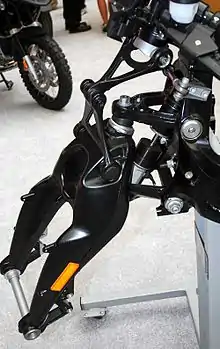
In 2004, BMW announced the K1200S, incorporating a new front suspension based upon a design by Norman Hossack.[48] BMW recognised this fact but paid Hossack no royalties.[49] BMW named its new front suspension the Duolever. As of 2018, the Duolever has been used on all K1300 and K1600 models.
The official BMW Motorrad explanation of the duolever includes this:[50]
The advantage of this front wheel suspension on the motorcycle market at present is its torsional rigidity. The BMW Motorrad Duolever front wheel suspension is not influenced by negative forces in the same manner as a conventional telefork whose fixed and take-off tubes twist laterally as well as longitudinally during jounce/rebound and steering. Its two trailing links absorb the forces resulting from the jounce/rebound and keep the wheel carrier stable. Thus, any torsioning is excluded and the front wheel suspension is very precise. The steering commands of the rider are converted directly and the feedback from the front wheel is transparent in all driving conditions.
A kinematical anti-dive effect is additionally achieved, just as for the Telelever, due to the arrangement of the trailing link bearings. While a conventional telefork during strong braking manoeuvres jounces heavily or locks, the Duolever still has sufficient spring travel remaining in this situation and therefore the rider can still brake into the corner extremely late yet directionally stable.
References
- "BMW Group Creates Two New Divisions". BMW Group. 27 September 2007. Archived from the original on 23 February 2009. Retrieved 2009-01-15.
- "BMW Motorrad achieves record sales for the fifth time in succession in 2015. Deliveries 10.9 % above previous year as of December. BMW Motorrad strategy takes effect". Archived from the original on 2016-09-27. Retrieved 2016-09-26.
- "BMW Celebrates Production of Its Two Millionth Motorcycle". autoevolution.com. 13 May 2011. Archived from the original on 19 May 2011. Retrieved 13 May 2011.
- Downes, Andy (11 November 2015). "New BMW G310R roadster revealed". Motor Cycle News. Archived from the original on 1 February 2016. Retrieved 30 January 2016.
- Sunny, Ken (12 November 2015). "TVS-BMW G310R 'Made in India' naked street motorcycle unveiled". International Business Times. Archived from the original on 5 March 2016. Retrieved 30 January 2016.
- "Berlin Plant". Manufacturing Facilities. BMW Group. Archived from the original on 2008-12-11. Retrieved 2008-09-18.
- Ash, Kevin (January 30, 2012). "Legendary design chief leaves BMW". Motor Cycle News. Archived from the original on May 2, 2012. Retrieved July 15, 2012.
- "David Robb leaves BMW". Visordown. January 30, 2012. Archived from the original on February 4, 2012. Retrieved July 15, 2012.
- Madson, Bart (January 30, 2012). "Running on Fumes". Motorcycle USA. Archived from the original on February 1, 2014. Retrieved July 15, 2012.
- "BMW Motorcycle Sales for 2009 and Prospects for 2010". webBikeWorld.com. 5 February 2010. Archived from the original on 13 May 2010. Retrieved 18 February 2010.
- "BMW MOTORRAD ACHIEVES RECORD SALES YET AGAIN IN 2007". Biker Voodoo. Archived from the original on 2008-05-06.
- Ziegler, Jessie. "BMW G450X – New thinking from a new player in the dirt bike market". Motorcyclist. Archived from the original on 29 December 2008. Retrieved 2009-01-07.
- "KYMCO Ships 450cc Enduro Bike Engines to BMW". China Economic News Service (CENS). 3 July 2008. Archived from the original on 21 February 2009. Retrieved 2009-01-09.
- "BMW's radical 3-wheeler on its way". Visordown. Archived from the original on 21 February 2009. Retrieved 2009-01-09.
- Brisette, Pete (15 December 2008). "2009 BMW G650GS Review". Motorcycle.com. Archived from the original on 30 January 2009.
- Madson, Bart (2 July 2010). "2011 BMW K1600GT First Look". Motorcycle USA. Archived from the original on 5 July 2010. Retrieved 22 July 2010.
- Organisation, A.S.O. - Amaury Sport. "History : Dakar". www.dakar.com. Archived from the original on 2016-09-19. Retrieved 2016-09-18.
- "History of Dakar - RETROSPECTIVE 1979-2007" (PDF). Dakar. Archived from the original (PDF) on 2010-06-01. Retrieved 2009-01-07.
- "Dakar Rally Winners (Bike Category)". MotorSports Etc. Archived from the original on 27 December 2008. Retrieved 2009-01-07.
- "News & Reviews - Carole Nash". carolenash.com. Archived from the original on 2018-03-26.
- "Michael Dunlop wins historic Isle of Man TT Superbike race for BMW Motorrad". www.press.bmwgroup.com. Archived from the original on 20 December 2016. Retrieved 9 May 2018.
- "Current Isle of Man TT Lap Records - Isle of Man TT Official Website". www.iomtt.com. Archived from the original on 28 August 2017. Retrieved 9 May 2018.
- "Archived copy" (PDF). Archived (PDF) from the original on 2016-06-15. Retrieved 2016-06-04.CS1 maint: archived copy as title (link)
- "Machines - Isle of Man TT Official Website". www.iomtt.com. Archived from the original on 23 August 2017. Retrieved 9 May 2018.
- Omorogbe, Jane (3 April 2008). "Ridden: BMW F800GS and F650GS". MSN. Archived from the original on 23 July 2011. Retrieved 11 November 2009.
- http://classic-motorbikes.net/wp/bmw-r90s/
- "Quick Spin: BMW R1100S BoxerCup Replika". What Bike: 39. Summer 2004.
- Cameron, Kevin (December 21, 2012). "BMW's All-New Water-Cooled Boxer - Tech Preview". Cycle World. Retrieved June 27, 2017.
- Brown, Roland (February 2, 2014). "BMW R nineT review". The Telegraph.
- "BMW R 18". BMW Motorrad Germany (in German). Retrieved 2020-04-04.
- Ker, Rod (May 2005). "BMW singles". Morton Way, Horncastle, UK: Mortons Media Group. Archived from the original on 2013-05-02. Retrieved 2013-05-23.
- BMW Archived 2019-04-20 at the Wayback Machine BMW technology site
- Madson, Bart (2 July 2010). "2011 BMW K1600GT First Look". Motorcycle USA. Retrieved 22 July 2010.
- Hull, Matt. "BMW K1600GT & K1600GT-L". RiDE Magazine (September 2010): 123. ISSN 1360-3507.
- Madson, Bart (10 November 2009). "BMW Inline Six Motorcycle Concept". Motorcycle USA. Retrieved 22 July 2010.
- Ash, Kevin (25 August 2010). "Six appeal for BMW tourers". The Daily Telegraph.
- "Archived copy". Archived from the original on 2016-03-03. Retrieved 2020-06-25.CS1 maint: archived copy as title (link)
- BMW Motorrad Deutschland Archived 2008-03-15 at the Wayback Machine
- BMW Motorcycles: Bikes: F 650 GS Archived 2008-03-02 at the Wayback Machine
- "BMW Motorrad International". Archived from the original on 2016-08-09. Retrieved 2020-06-25.
- BMW Motorrad (6 October 2008). "BMW Product Name History". Motorcycle.com. Retrieved 19 November 2012.
- Wilson, Byron (September 30, 2014). "2015 BMW R1200R First Look". MotorcycleUSA.com. Archived from the original on 2014-11-11. Retrieved 2014-11-11.
- Falloon, Original BMW Air-Cooled Boxer Twins 1950–1996, pp 13–14
- Holmstrom & Nelson, p. 64
- GB patent 693646, Earles, Ernest, "Motor cycle front wheel forks", published 1953-07-01
- "Sportsbikes reviews: BMW R1100S (1998 - 2005)". Visordown. 14 September 2010. Archived from the original on 26 December 2014.
- "BMW R1100S". What Bike?: 41. Summer 2004.
- "BMW K1200S". Hossack Design. Retrieved 22 March 2010.
- "What is our fork technology?" Archived 2018-09-04 at the Wayback Machine, broughsuperiormotorcycles.com
- "Duolever". BMW Motorrad. Archived from the original on 26 June 2006. Retrieved 22 March 2010.
External links
| Wikimedia Commons has media related to BMW Motorrad. |
